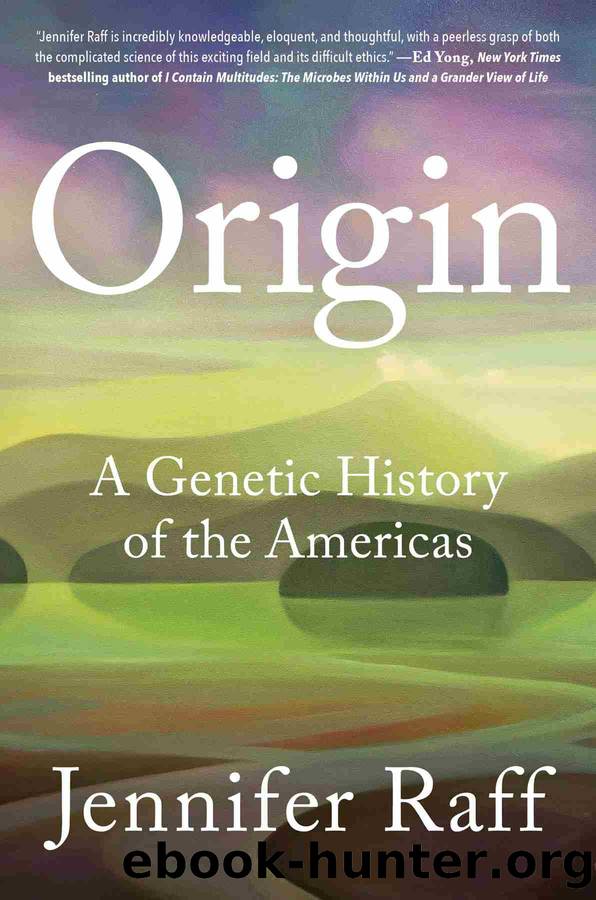Origin by Jennifer Raff

Author:Jennifer Raff [RAFF, JENNIFER]
Language: eng
Format: epub
Publisher: Grand Central Publishing
Published: 2022-02-08T00:00:00+00:00
I carried the tubes into the innermost room of the lab. This was the tiny space past the garbing room and the extraction room kept at the highest positive pressure level of the lab complex. We reserved this room for activities involving the extracted DNA and negative controls. Inside one of three benchtop hoods I began to add tiny quantities of chemicals into small tubes to facilitate the next step in the process: determining whether there was any DNA present in my extraction and negative control. The chemical reaction that I was going to employ in this stepâcalled the polymerase chain reaction, or PCRâwould produce millions of copies of a small region of human mitochondrial DNA. In this case, I would target a section of the mitochondrial genome that did not code for any proteins. I would melt the DNA double helix into its two strands with a machine that controlled temperature. Each strand would then serve as a template for making a new strand within a cocktail of chemicals that imitated the DNA copying mechanisms that cells use for reproducing their own genomes. I would target a small regionâless than 100 DNA bases longâfor amplification with two short, custom-made DNA fragments called primers. The primers would bracket the targeted region and help direct the DNA copying mechanisms to that site (4).
I also added another set of negative controls to this stage so that I might be able to distinguish between contamination that occurred during this step of the process and during the extraction process.
As I squinted at my pipette tips to verify that I was doing things correctly, I remembered the words of James José Bonner, a kindly molecular biologist who took me on as a lab assistant when I was a high school senior. âMost of this job,â he told me, âis about moving minuscule quantities of liquid from one tube to another.â He was absolutely right (5). Lab workers in the ancient DNA world add additional layers of anticontamination tedium on top of this approach. The people who donât love benchwork often end up specializing in the analysis side of science, like programming and modeling (6). Some impressive souls do both. After my inspection, I carefully closed the lids of the tubes so that no modern DNA could get into them once outside of the clean room, and carried them through the three rooms, repeating the tedious procedure of bleaching surfaces, removing my protective garb, turning on the UV lights. Nothing happens quickly in the ancient lab.
The next steps in this process would take place in the âmodernâ lab, a completely separated space. The closer the two labs, the greater the chance that PCR-amplified DNA could get back into the ancient lab, where they pose just as much risk to contaminating the sample as my own DNA. To prevent inadvertently transporting DNA between the two labs, we have strict movement protocols in place; chief among them is that nobody may, for any reason whatsoever, go into the ancient DNA lab the same day after going into the modern lab.
Download
This site does not store any files on its server. We only index and link to content provided by other sites. Please contact the content providers to delete copyright contents if any and email us, we'll remove relevant links or contents immediately.
| Fossils | Game Theory |
| Genetics | Molecular Biology |
| Organic | Paleontology |
Sapiens: A Brief History of Humankind by Yuval Noah Harari(14242)
Sapiens by Yuval Noah Harari(5293)
Pale Blue Dot by Carl Sagan(4904)
Homo Deus: A Brief History of Tomorrow by Yuval Noah Harari(4818)
Livewired by David Eagleman(3680)
Origin Story: A Big History of Everything by David Christian(3648)
Brief Answers to the Big Questions by Stephen Hawking(3368)
Inferior by Angela Saini(3276)
Origin Story by David Christian(3145)
Signature in the Cell: DNA and the Evidence for Intelligent Design by Stephen C. Meyer(3070)
The Gene: An Intimate History by Siddhartha Mukherjee(3046)
The Evolution of Beauty by Richard O. Prum(2936)
Aliens by Jim Al-Khalili(2785)
How The Mind Works by Steven Pinker(2728)
A Short History of Nearly Everything by Bryson Bill(2627)
Sex at Dawn: The Prehistoric Origins of Modern Sexuality by Ryan Christopher(2481)
From Bacteria to Bach and Back by Daniel C. Dennett(2441)
Endless Forms Most Beautiful by Sean B. Carroll(2428)
Who We Are and How We Got Here by David Reich(2396)
